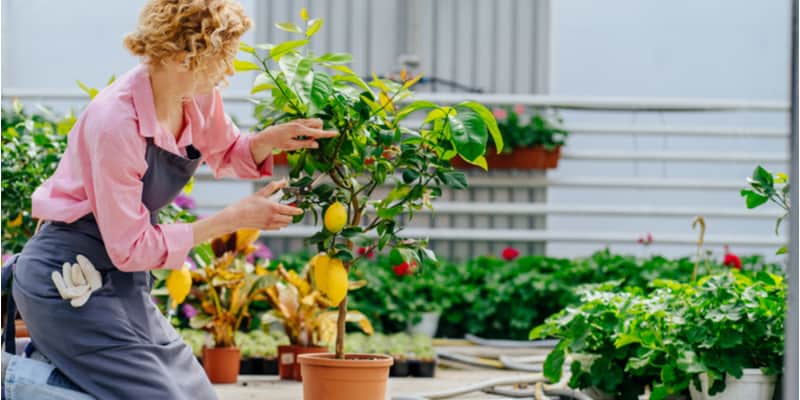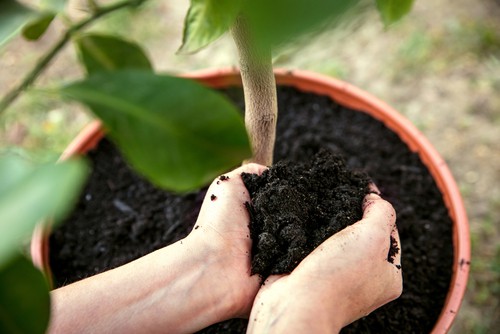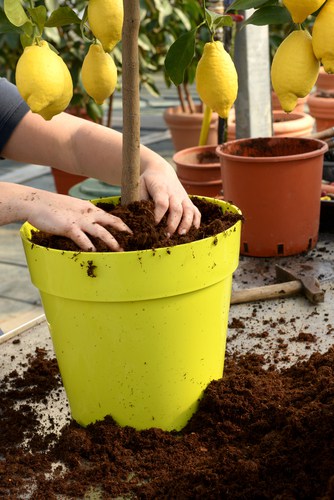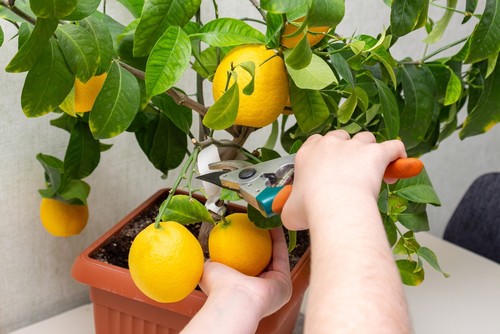
How to look after a lemon tree?
Our site is reader supported, this means we may earn a small commission from Amazon and other affiliates when you buy through links on our site.
To successfully look after a lemon tree, you need to pay attention to three things: watering, nutrients and the environment.
Watering
The two main things to keep in mind when setting up a watering schedule for your lemon tree are:
- They very much dislike a drought-and-flood environment.
- Their watering needs in the summer and in the winter are very different.
Citrus tree gardening experts recommend that you thoroughly water your lemon tree in its summer waterings. They suggest removing the pot from any basket or container it’s sitting in and watering the soil until the water runs out of the bottom of the pot. Accordingly, make sure to let all the water run out that needs to. This ensures that the roots receive water but don’t become waterlogged. If the soil is densely packed, you may need to pass water through it several times.
Summer watering
In the summer, allow about half the soil to dry out before watering again. The time between waterings depends on the environment your lemon tree is in (heat and humidity) as well as how much water the tree actually sucks up. You need to monitor your lemon tree’s needs and come to understand them.
Always use lukewarm water, preferably rain water. The roots are quite sensitive and will react in horror to cold water. If you must use tap water, run it into a bucket first and let it sit for 24 hours to reduce the chlorine.
Winter watering
In winter, greatly reduce the watering schedule. The lemon tree should be dormant and not need much moisture. (See the article Can I leave my lemon tree outside in winter? for information about how to overwinter your tree.) Over-watering is a common problem at this time.
Keep an eye on how the leaves behave to know if you’re giving the tree enough water. Wilting leaves indicate under-watering while yellowing leaves and a soft stem are signs of over-watering.
Just remember: water liberally in the summer and sparingly in the winter.
Nutrients
All citrus trees are hungry plants and lemon trees are no exception. Even if your soil is nutrient-rich, consider applying a specialty fertiliser for citrus trees. The summer months are the prime growth season, so fertilise then. Don’t ignore the lemon tree’s nutrient needs in the winter when it’s dormant. You don’t have to fertilise as often and you can also find fertilisers especially for this dormant period.
Environment
A lemon tree’s environment consists of four elements: soil, light, humidity and heat. You need to look after the lemon tree in all four areas.
Soil
The soil you plant your lemon tree in needs to be nutrient-rich and drainable. A good potting soil works well as does a soil-based compost. Don’t use anything that becomes waterlogged or, alternately, can’t hold water at all. Feel free to use well-rotted garden compost or animal manure on top. This provides nutrients as well as stops water from evaporating from the surface.
Light
The lemon tree needs around four to six hours of sunlight per day. Off-peak sunlight – in the morning and afternoon – is best for its continued health. Too much heat from noon-time light can hurt the roots through root burn. You should provide this amount of light year round, so you may need a grow lamp in the darker winter months.
Humidity
Lemon trees prefer moist environments. In the summer outdoors, keeping the tree watered well should provide this. Plus there’s also the more-than-occasional rainstorm to keep the air humid. This is different from the winter indoors, when your best bet is to place the tree container on a bed of gravel stones. Use water on the stones to just below the top of them, and this creates moist air around the tree. This is especially important if the tree is over-wintering in a centrally heated room.
Heat
The minimum temperature that lemon trees like is around 8°C to 10°C. As a result, when the nights become cooler than this, it’s time to move your plant to its winter home. Different guidelines applying to look after a lemon tree in its dormant time.
Additionally, a lemon tree needs to be in a cooler temperature environment (around 12°C) in the winter so it can become dormant for the right length of time. This gives it time to rest and gather strength for the flowering period in the summer. A lack of flowers can often be traced to an inadequate dormant period.
Removing fruit
I do appreciate that it’s exciting when lemons start to appear on your tree. But it takes the tree a lot of energy to keep all those lemons growing. Gardening experts recommend that, if your tree is 1m tall or shorter, you only keep about 20 lemons growing on it. Generally, pluck the rest off and give the tree a chance to fully develop those 20. Even healthy trees have limited energy, so use it wisely.
Dealing with problems
If you notice a problem with your lemon tree’s health, please turn to the appropriate article in my Lemon Tree series. On the whole, I cover the most common problems:
- Why is my lemon tree losing leaves?
- Why has my lemon tree got sticky leaves?
- Why are my lemon tree leaves turning yellow?
- Why is my lemon tree not flowering?
- Why is my lemon tree not producing fruit?



